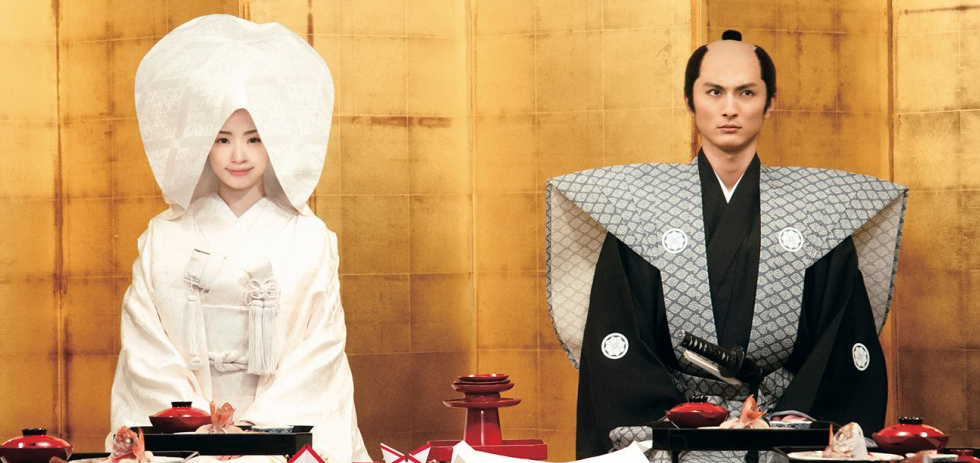
There must a massive warehouse outside Kyoto, Yokohama or Kobe – forgive me, my knowledge of Japanese industrial geography is limited – which stocks nothing but the various props, costumes, upholstery and scenery required for the dozens of jidaigeki (literally ‘period dramas’) made each year. They probably have an old prop sword once swung by Toshirô Mifune, and a dusty Setsuko Hara kimono from Tokyo Story. Their main stock in trade these days, though, must be films like A Taste of Samurai Cooking – A True Love Story, whose 18th-century setting, replete with as many tatami mats, screen doors and wicker bowls as the prop budget would allow, seems to have been designed explicitly to create a viable audience draw for an otherwise humdrum two-hour diversion. Yuzo Asahara’s film falls flat in most regards: awfully paced, poorly designed, and inexplicably uninterested in its main thematic conceit – the food – it ends up looking and feeling like a Japanese renaissance fair, an insipid and vaguely cringeworthy imitation of real history.
Not that there’s anything wrong with a bit of levity. The central plot of A Taste of Samurai Cooking is intriguing in its potential for a sideways, knowing look at the quotidian lives of low-ranking samurai – the Funaki family into which Haru, the protagonist (Aya Ueto), marries is titled and honourable but certainly not wealthy, its patriarch Dennai (Toshiyuki Nishida) having lived in the service of more eminent men as a cook for many years. When Haru is married to his son Yasunobu (Kengo Kôra), embittered at having to take on his father’s role after his older brother’s death due to a more natural talent for swordsmanship, there are some intimations that the film may use its foodie focus as an opportunity to subvert some of the more absurd stringent social protocols its characters are forced to observe. Particularly with Ueto rather than Kôra as the billed star, and with the implied subtext of the ‘shame’ of cooking for others, A Taste of Samurai Cooking seemed ready to aim for the canon of great films excoriating the attitude to women displayed in historical Japanese society.
Unfortunately, any semblance of satire fizzles out immediately; Haru spends most of the film on her knees apologising profusely for minor errors, while the talk of inter-clan marriages and scandalous divorces is never used to make any meaningful point about love or class. Having failed to use the relatively light-hearted plot for subversion, it instead draws unwanted attention to the subpar mise-en-scène. Supposed Edo-period regional Japan seems altogether too polished and ostentatious (perhaps the props came new, straight from that warehouse). An outdoor ceremony takes place on a shiny dark wood platform that wouldn’t look out of place in an IKEA catalogue, minimalist home living areas evoke Ozu’s 1950s Tokyo more than a dwelling centuries previous, and several male actors, Kôra included, look decidedly uncomfortable with their samurai topknot haircuts. I half expected to glimpse the catering truck creep into the edge of a shot.
The film’s pacing, though, it its unsurvivable weakness. Director Asahara’s previous credits primarily include several installations of a long-running comedy series about fishing (which I suspect were not too technically taxing), and his work here at managing plot strands is inept. Massive plot developments such as deaths are announced with little fanfare via voiceover, while dry discussions of the virtues of different types of parsley seem to take up most of the running time. Three-quarters of the film pass before any of the characters show any interest in anything, at which point Yasunobu decides to run off to join a populist rebellion, before being thwarted by Haru to save his life. Credit where credit’s due: the political intrigue in the build-up to the ‘disturbance’ is shot in a few taut, ominous scenes, and may have made a good film by itself in a darker, more classic jidaigeki style. Here, however, the whole plotline is bizarrely out of place and wholly ineffective.
The film’s other baffling decision is its seeming lack of interest in the food which the ‘kitchen samurai’ and Haru actually cook, made even stranger by the revelation that their real-life counterparts actually conceived many Japanese dishes now considered national mainstays. On numerous occasions, the gastronomically talented Haru creates a dish that is met with a chorus of praise, and explains coyly how she made it so delicious, but we are never shown her preparing or serving the food – surely the major attractions for viewers enamoured of Japanese cuisine? Other food films – the surprisingly charming recent Meryl Streep vehicle Julie & Julia or the Dane Bille August’s renowned Babette’s Feast, for example – revel in the frustrating, humorous and rewarding process of creation involved in cooking. As it is, the spectacle of cuisine in A Taste of Samurai Cooking is reduced to what feels like about thirty scenes of Haru soaking leaves in bowls, an all-too-hasty montage of the final banquet, and some ugly sequences of people hacking various sea creatures to pieces. Bon appetit.
